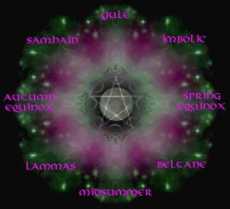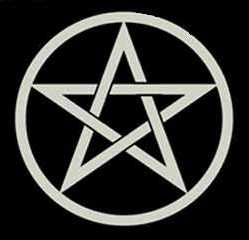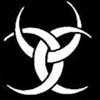History of Witchcraft
 |
| Yule/Winter Solstice on December 21,Imbolc/Imbolg/Candlemas on February 2, Ostara/Spring Equinox on March 21, Beltaine/Beltane/May Day on May 1, Midsummer/Summer Solstice on June 21, Lughnasadh/Lammas on August 1, Mabon/Autumn Equinox on September 21, Samhain/All Hallow's Eve/Halloween on October 31 |
The roots of magic come from the Celts, a people living between 700 BC and 100 AD. Believed to be descendants of Indo-Europeans, the Celts were a brilliant and dynamic people - gifted artists, musicians, storytellers, metalworkers, expert farmers and fierce warriors. They were much feared by their adversaries, the Romans, who eventually adopted a number of their customs and traditions.
The Celts were a deeply spiritual people, who worshiped both a god and goddess. Their religion was pantheistic, meaning they worshiped many aspects of the "One Creative Life Source" and honored the presence of the "Divine Creator" in all of nature. Like many tribes the world over, they believed in reincarnation. After death, they went to the Summerland for rest and renewal while awaiting rebirth.
The months of the Celtic year were named after trees. The Celtic new year began at Samhain, which means "summers end," and was the final harvest of the year. This was also their "Festival of the Dead," where they honored their ancestors and deceased loved ones. Many contemporary Halloween customs come from Samhain.
Next on the wheel of the Celtic year was the Winter Solstice, celebrating the annual rebirth of the Sun. Our Christmas customs today are similar to this ancient celebration. Around the beginning of February came Imbolg, a time when domesticated animals began to give birth. The Spring Equinox and Beltaine, sometimes called "May Day," were fertility festivals. The Summer Solstice, known as Lughnasadh, celebrated the glory of the Sun and the powers of nature. Lughnasadh, the Fall Equinox, and Samhain, were considered as Celtic harvest festivals.
The "Druids" were the priests of the Celtic religion. They remained in power through the fourth century AD, three centuries after the Celts' defeat at the hands of the Romans. The Druids were priests, teachers, judges, astrologers, healers and bards. They became indispensable to the political leaders, giving them considerable power and influence. They were peacemakers, and were able to pass from one warring tribe to another unharmed. It took twenty years of intense study to become a Druid.
Translated, the word Druid means "knowing the oak tree." Trees, the oak in particular, were held sacred by the Celts. Mistletoe, which grows as a parasite on oak trees, was a powerful herb used in their ceremonies and for healing. Mistletoe was ritually harvested at the Summer Solstice by cutting it with a golden sickle and catching it with a white cloth while never letting it fall to the ground.
The religious beliefs and practices of the Celts grew into what later became known as Paganism, not to be confused with the term Neo-Paganism, which is beyond the scope of this writing. The word Pagan is derived from the Latin word Paganus, meaning "country dweller." This outgrowth was consistent with the Celts' love for the land and their holding such things as the oak tree and mistletoe sacred.
Paganistic beliefs and rituals blended with those of other Indo-European descended groups, and over several centuries spawned such practices as concocting potions and ointments, casting spells, and performing works of magic. These practices, along with many of the nature-based beliefs held by the Celts and other groups, became collectively known as witchcraft.
The term witch, which means to "twist or bend," has its origin in the ancient, Anglo-Saxon word "wicca," which is derived from the word "wicce," which means "wise." Witch is also related to the German word, "weihen," which means "to consecrate or bless." Some say that the origins of the witch date back thousands of years, to the days when the goddess was worshiped and humanity had great reverence for the powers of nature and for women as creators of new life. In the "New Age" philosophy, this relates to the concept of "Gaea," or "Mother Earth," which views planet earth as essentially a living being.
Prior to the 14th century, witchcraft came to mean a collection of beliefs and practices including healing through spells, mixing ointments or concoctions, dabbling in the supernatural, divining or forecasting the future, and engaging in clairvoyance. Groups holding to other beliefs and rituals often branded witchcraft as "demon-worship."
After North America was discovered and Europeans began migrating to the new land, witchcraft came into practice by some of the early, colonial settlers. Since it had previously been branded as "demon-worship," witchcraft was forbidden throughout the North American colonies. Despite this decree by the powers of the day, some colonists secretly practiced witchcraft knowing they would be hanged or burned if caught. It has been said that certain rituals performed by early-American witches helped shield their settlements from attacks by Native Americans.
Magic can effect many outcomes, some good and some evil, depending on the type of magic and the intentions of the practitioner.


